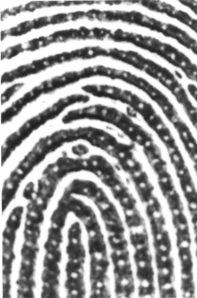"Level Three" Friction Ridge Features
Level three detail consisting of Pore Structure, Ridge periphery and Incipient ridges.
Poroscopy is the study of the size, shape, relative position, arrangement and frequency of sweat pores.
Edgeoscopy is the study of the friction ridge edges for their alignment and the shape of their individual ridge units, as well as the shapes and alignments of pores close to the ridge edges which appear as notches.
Ridgeology is the study of the uniqueness of all friction ridge skin formations and their use as a means of personal identification.
Edgeoscopy is the study of the friction ridge edges for their alignment and the shape of their individual ridge units, as well as the shapes and alignments of pores close to the ridge edges which appear as notches.
Ridgeology is the study of the uniqueness of all friction ridge skin formations and their use as a means of personal identification.
"Level Three" Friction Ridge Features
"Level Three" friction skin detail is the structural features of a single unit of friction ridge skin. Examination of Level Three detail focuses on the dimensional attributes of individual ridge units - such as their shape, width and edge contour. Level Three study also encompasses the placement, as well as the structural and dimensional attributes, of the pores. The study of Level Three detail incorporates the Friction Ridge Identification specializations of Ridgeology, Poreology and Edgeology (see definitions at the left frame). Magnification of the friction ridges is necessary in order to view "Level Three" detail.
"Level Three" friction ridge features begin during the early stages of fetal life and are subject to a myriad of epidermal configurations, differential growth, and alignment factors that result in unique and distinguishing arrangements of "Level Three" detail for each and every person born. Research conducted since the 1800's has established that the stressors in growth affecting the friction skin formations is so varied that the "Principle of Uniqueness" of fingerprints is certain.
For correspondence between the latent print and the known print, the "Level Three" detail would be in agreement in the same area of both impressions in their a.) shape, b.) location, c.) orientation and d.) group relationship, with no genuine difference in their appearance or arrangement.
Used in conjunction with "Level One" and "Level Two" details, "Level Three" detail can be used to formulate an Individualization. "Level Three" detail can be used in conjunction with "Level One" and "Level Two" details to effect an Exclusion.
"Level Three" friction ridge features begin during the early stages of fetal life and are subject to a myriad of epidermal configurations, differential growth, and alignment factors that result in unique and distinguishing arrangements of "Level Three" detail for each and every person born. Research conducted since the 1800's has established that the stressors in growth affecting the friction skin formations is so varied that the "Principle of Uniqueness" of fingerprints is certain.
For correspondence between the latent print and the known print, the "Level Three" detail would be in agreement in the same area of both impressions in their a.) shape, b.) location, c.) orientation and d.) group relationship, with no genuine difference in their appearance or arrangement.
Used in conjunction with "Level One" and "Level Two" details, "Level Three" detail can be used to formulate an Individualization. "Level Three" detail can be used in conjunction with "Level One" and "Level Two" details to effect an Exclusion.
